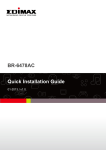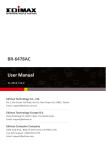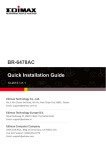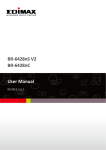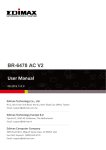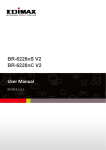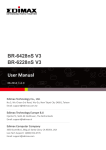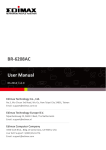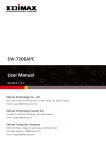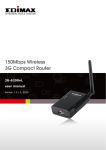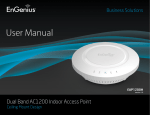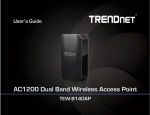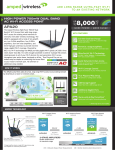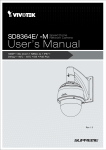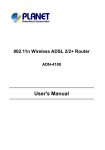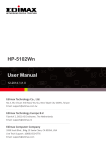Download BR-6478AC User Manual
Transcript
BR-6478AC User Manual 02-2013 / v1.0 1 COPYRIGHT Copyright Edimax Technology Co., Ltd. all rights reserved. No part of this publication may be reproduced, transmitted, transcribed, stored in a retrieval system, or translated into any language or computer language, in any form or by any means, electronic, mechanical, magnetic, optical, chemical, manual or otherwise, without the prior written permission from Edimax Technology Co., Ltd. Edimax Technology Co., Ltd. makes no representations or warranties, either expressed or implied, with respect to the contents hereof and specifically disclaims any warranties, merchantability, or fitness for any particular purpose. Any software described in this manual is sold or licensed as is. Should the programs prove defective following their purchase, the buyer (and not this company, its distributor, or its dealer) assumes the entire cost of all necessary servicing, repair, and any incidental or consequential damages resulting from any defect in the software. Edimax Technology Co., Ltd. reserves the right to revise this publication and to make changes from time to time in the contents hereof without the obligation to notify any person of such revision or changes. The product you have purchased and the setup screen may appear slightly different from those shown in this QIG. For more information about this product, please refer to the user manual on the CD-ROM. The software and specifications are subject to change without notice. Please visit our website www.edimax.com for updates. All brand and product names mentioned in this manual are trademarks and/or registered trademarks of their respective holders. Edimax Technology Co., Ltd. Add: No. 3, Wu-Chuan 3rd Rd., Wu-Ku Industrial Park, New Taipei City, Taiwan Tel: +886-2-77396888 Email: [email protected] Notice According to GNU General Public License Version 2 This product includes software that is subject to the GNU General Public License version 2. The program is free software and distributed without any warranty of the author. We offer, valid for at least three years, to give you, for a charge no more than the costs of physically performing source distribution, a complete machine-readable copy of the corresponding source code. 2 CONTENTS I. PRODUCT INFORMATION......................................................................................... 5 I-1. Package Contents ........................................................................................ 5 I-2. Hardware .................................................................................................... 6 I-3. LED Status ................................................................................................... 6 I-4. Safety Information ...................................................................................... 8 I-5. Features ...................................................................................................... 8 II. HARDWARE INSTALLATION & NETWORK SETTINGS.................................................. 9 II-1. Hardware Installation ................................................................................. 9 II-2. Network Settings ........................................................................................ 9 II-2-1. Windows XP ............................................................................................... 9 II-2-2. Windows Vista.......................................................................................... 13 II-2-3. Windows 7................................................................................................ 14 II-2-4. Windows 8................................................................................................ 17 III. SETTING UP ........................................................................................................... 21 III-1. iQ Setup .................................................................................................... 21 III-2. Manual Setup via Web Browser ................................................................ 26 IV. BROWSER BASED CONFIGURATION INTERFACE...................................................... 28 IV-1. Status........................................................................................................ 28 IV-2. Setup Wizard ............................................................................................ 28 IV-3. Internet..................................................................................................... 29 IV-3-1. WAN Setup ............................................................................................... 29 IV-3-1-1. Dynamic IP ................................................................................................ 31 IV-3-1-2. Static IP ..................................................................................................... 32 IV-3-1-3. PPPoE ....................................................................................................... 33 IV-3-1-4. PPTP/L2TP ................................................................................................. 34 IV-3-1-5. WISP ......................................................................................................... 37 IV-3-2. DDNS ........................................................................................................ 37 IV-4. LAN ........................................................................................................... 39 IV-5. 2.4GHz Wireless........................................................................................ 40 IV-5-1. Basic Settings ............................................................................................ 41 IV-5-1-1. Wireless Security ...................................................................................... 43 IV-5-1-1-1. WEP ...................................................................................................... 43 IV-5-1-1-2. WPA pre-shared key ............................................................................. 43 IV-5-1-1-3. WPA RADIUS ......................................................................................... 44 IV-5-2. Guest Wireless Settings .............................................................................. 45 IV-5-3. WPS ............................................................................................................ 46 IV-5-4. Access Control ............................................................................................ 46 IV-5-5. Wireless Schedule ....................................................................................... 47 IV-6. 5GHz Wireless ................................................................................................ 48 IV-7. Security .......................................................................................................... 50 IV-7-1. URL Blocking ............................................................................................... 50 3 IV-7-2. Access Control ............................................................................................ 51 IV-8. QoS (Quality of Service) ................................................................................. 52 IV-8-1. QoS ............................................................................................................. 52 IV-8-2. iQoS ............................................................................................................ 55 IV-9. Advanced ....................................................................................................... 56 IV-9-1. Static Routing .............................................................................................. 56 IV-9-2. Port Forwarding .......................................................................................... 57 IV-9-3. Virtual Server .............................................................................................. 57 IV-9-4. 2.4GHz Wireless .......................................................................................... 58 IV-9-5. 5GHz Wireless ............................................................................................. 60 IV-9-6. ALG ............................................................................................................. 60 IV-9-7. IGMP ........................................................................................................... 61 IV-9-8. DMZ ............................................................................................................ 61 IV-9-9. Firewall ....................................................................................................... 62 IV-9-10. UPnP ......................................................................................................... 63 IV-10. Administration ............................................................................................. 64 IV-10-1. Time Zone ................................................................................................. 64 IV-10-2. Password................................................................................................... 64 IV-10-3. Remote Access .......................................................................................... 65 IV-10-4. Backup / Restore ....................................................................................... 65 IV-10-5. Upgrade .................................................................................................... 66 IV-10-6. Restart ...................................................................................................... 66 IV-10-7. Logs........................................................................................................... 67 IV-10-8. Active DHCP Client .................................................................................... 67 IV-10-9. Statistics.................................................................................................... 68 V. TROUBLESHOOTING........................................................................................... 69 VI. GLOSSARY ........................................................................................................ 70 4 I. PRODUCT INFORMATION Thank you for purchasing an Edimax BR-6478AC AC1200 wireless concurrent dual-band gigabit router. I-1. Package Contents Before you start using this product, please check if there is anything missing in the package, and contact your dealer to claim the missing item(s): BR-6478AC Quick Installation Guide CD-ROM Power Adapter 5 Ethernet I-2. Hardware Item Name Antenna Radio ON/OFF Switch Reset / WPS Button Gigabit LAN Ports Gigabit WAN Port 5V Power Port I-3. Description Connects the supplied 3dBi antennas. Switch the wireless signal on/off accordingly. Resets the router to factory default settings (clears all settings) or starts the WPS function. Reset: Press and hold for 12 seconds to restore all settings to factory defaults. WPS: Press this button for 2 5 seconds to activate the WPS function. Connects via Ethernet cable to a computer or other network devices. Connects to cable/xDSL modems. Connects to the supplied power adapter. LED Status 6 LED Power Internet 2.4 GHz 5 GHz LED Status On Router is on. Off Router is off. Flashing 2.4GHz LAN activity (transferring/receiving data). Off 2.4GHz wireless is not active. On 5GHz wireless is active. On Flashing Off On Flashing Off On WAN LAN 1 4 Description Flashing Internet connection is active. Router is connecting to internet. No internet connection. 2.4GHz wireless is active. 5GHz LAN activity (transferring/receiving data). 5GHz wireless is not active. WAN port connected. WAN activity (transferring/receiving data) Off WAN port not connected. On LAN port connected. LAN activity (transferring or receiving data). LAN port not connected. Flashing Off 7 I-4. Safety Information In order to ensure the safe operation of the device and its users, please read and act in accordance with the following safety instructions. 1. The router is designed for indoor use only; do not place the router outdoors. 2. Do not place the router in or near hot/humid places, such as a kitchen or bathroom. 3. Do not pull any connected cable with force; carefully disconnect it from the router. 4. The device contains small parts which are a danger to small children under 3 years old. Please keep the router out of reach of children. 5. Do not place the router on paper, cloth, or other flammable materials. The router will become hot during use. 6. There are no user-serviceable parts inside the router. If you experience problems with the router, please contact your dealer of purchase and ask for help. 7. The router is an electrical device and as such, if it becomes wet for any reason, do not attempt to touch it without switching the power supply off. Contact an experienced electrical technician for further help. 8. If you smell burning or see smoke coming from the router then unplug the router immediately, as far as it is safely possible to do so. Call your dealer of purchase for help. I-5. Features Supports IEEE 802.11ac & IEEE 802.11a/b/g/n concurrent dual-band connections on 2.4GHz and 5GHz bands. Wireless data transmission rate up to 1167Mbps (2.4GHz 300Mbps + 5GHz 867Mbps). 4 gigabit LAN ports (data transmission rates up to 1000Mbps). Comply with IEEE 802.3/ 802.3u/ 802.3ab standards. Smart and automated iQ Setup. iQoS for quick and easy bandwidth management. Build-in hardware button to enable/disable the wireless signal. Wireless signal on/off scheduling function. Supports DHCP, Static IP, PPPoE, PPTP, L2TP and WISP connection modes. 8 Supports WMM, WEP, WPA, WPA2, DDNS, QoS, IP/MAC filter, DMZ and virtual server. II. HARDWARE INSTALLATION & NETWORK SETTINGS II-1. Hardware Installation Please setup your router, computer, modem and other network devices as shown below. Before using the BR-6478AC, please make sure your computer is set to use a dynamic IP address. This means your computer can obtain an IP address automatically from a DHCP server. Please refer to instructions appropriate for your operating system. II-2. II-2-1. 1. Network Settings Windows XP 9 2. ndow will appear. 3. 10 4. 5. 11 DNS server 12 1. II-2-2. Windows Vista - 2. 13 -left corner of your II-2-3. 1. Windows 7 -left corner of your 14 2. 3. 15 4. 5. 16 6. II-2-4. server Windows 8 1. From the Windows 8 Start screen, you need to switch to desktop mode. Move your curser to the bottom left of the screen and click. 17 2. In desktop mode, click the File Explorer icon in the bottom left of the screen, as shown below. 3. 18 4. 5. side. 19 6. 7. 20 III. SETTING UP III-1. iQ Setup iQ Setup is a simple and intelligent WAN detection tool. Please follow the instructions below. 1. Use a Wi-Fi device (e.g. computer, tablet, smartphone) to search for a Wi-Fi 2. Open a web browser and if you do not automatically arriv http://edimax.setup. Select your language from the drop down menu and click to begin the setup process. 21 Note: If you cannot access http://edimax.setup , please make sure your computer is set to use a dynamic IP address. See II. NETWORK SETTINGS 3. Ensure that your router is properly connected to your modem as shown on the screen, and click to continue. 22 4. Please wait a moment while the BR-6478AC detects your WAN connection type. 5. The BR-6478AC will display the next screen depending on your WAN connection type. For Dynamic IP users please click 23 to continue: For PPPoE users please enter the username and password provided by your ISP and click to continue: For other users please select your WAN connection type manually from the drop down menu, click to continue and follow the on-screen instructions. Note: If you are not sure which WAN connection type to choose, please contact your ISP. 24 6. Please enter a network name (SSID) and Wi-Fi Password for each of the BR-Fi networks and click to continue. Note: Please remember these details. For your convenience, you can write them down at the end of - 7. You will see the screen below, displaying a summary of your W-Fi settings and that configuration is now complete. Please click to continue. 25 8. complete. Please close your browser window. ation is now III-2. Manual Setup via Web Browser 1. 2. . 26 3. Input the us You will arrive the at Status page, use the menu on the left side of the screen to navigate. You can also change the language using the drop down menu in the top right corner. Refer to IV. BROWSER BASED CONFIGURATION INTERFACE. 27 IV. BROWSER BASED CONFIGURATION INTERFACE Once you have setup the router as detailed in III-1. iQ Setup or the included QIG, you can further configure the settings of the router or run iQ Setup again using the browser based configuration interface. If you prefer, you can also skip iQ Setup and configure the router manually. IV-1. Status The Status page shows the basic status and information of the router. Note: Screenshots shown in this manual are examples. The information you see on your screen will be unique to your configuration. IV-2. Setup Wizard To perform iQ Setup again and reconfigure the router from the menu on the left side. 28 Setup Wizard You will see the screen below. Please refer back to III-I iQ Setup onwards for guidance on iQ Setup. IV-3. IV-3-1. Internet WAN Setup Select a Wide Area Network (WAN) connection mode from the drop down menu. After you select your connection mode and complete the configuration, the router will restart for the changes to take effect. Note: If you are not sure which WAN connection mode you should use, please contact your Internet Service Provider (ISP). 29 Dynamic IP Static IP PPPoE PPTP L2TP WISP Select if your Internet Service Provider assigns an IP address to you automatically using DHCP (Dynamic Host Configuration Protocol) (e.g. cable internet providers). ISP provides you with a fixed IP address. if your ISP provides internet access via Point-to-Point Protocol over Ethernet (PPPoE) (usually ADSL users). provides internet access via Point-to-Point Tunneling Protocol (PPTP). Sele nternet access via Layer 2 Tunneling Protocol (L2TP) if your ISP provides wireless internet access. 30 IV-3-1-1. Host Name MAC Address DNS address DNS1 DNS2 DNS3 MTU TTL Dynamic IP Input the host name of your computer (only required if your ISP instructs you to do so). If your ISP only permits computers with certain MAC addresses to access the internet, input the MAC address of your computer here. If your computer is connected to internet via cable modem, to enter the MAC address automatically. Obtain an IP address automatically the followin . If you choose , below. Input the address of DNS1 assigned by your ISP. Input the address of DNS2 assigned by your ISP. Input the address of DNS3 assigned by your ISP. Input the MTU (maximum transmission unit) value of your network connection. The default value, which is typical for a dynamic IP or static IP, is 1500. Enable requires you to do so. 31 Most Dynamic IPs assigned to users by ISPs are configuration free IV-3-1-2. Static IP IP Address Subnet Mask Default Gateway Address MAC Address DNS1 DNS2 DNS3 MTU Input the static IP address assigned by your ISP. Input the subnet mask assigned by your ISP. Input the default gateway address assigned by your ISP. If your ISP only permits computers with certain MAC addresses to access the internet, input the MAC address of your computer here. If your computer is connected to internet via cable modem, to enter the MAC address automatically. Input the address of DNS1 assigned by your ISP. Input the address of DNS2 assigned by your ISP. Input the address of DNS3 assigned by your ISP. Input the MTU (maximum transmission unit) 32 TTL IV-3-1-3. User Name Password MAC Address PPPoE value of your network connection. The default value, which is typical for a dynamic IP or static IP, is 1500. Enable you to do so. Enter the user name assigned by your ISP. Enter the password assigned by your ISP. If your ISP only permits computers with certain MAC addresses to access the internet, input the MAC address of your computer here. If your computer is connected to internet via cable modem, to enter the MAC address automatically. 33 DNS address Obtain an IP address automatically . If you choose , DNS1 DNS2 DNS3 TTL Service Name MTU Connection Type Idle Time Out Addres below. Input the address of DNS1 assigned by your ISP. Input the address of DNS2 assigned by your ISP. Input the address of DNS3 assigned by your ISP. Enable uires you to do so. Input the Service Name assigned by your ISP. Input the MTU (maximum transmission unit) value of your network connection. The default value is 1392. Typical values for ADSL are 1392 or 1492. Select connection type from: always connected. connect when required. connect and disconnect manually. For length of inactivity required to disconnect. Enable Dual Wan Access If your ISP provides a dual- IV-3-1-4. the PPTP/L2TP Fields for PPTP and L2TP connections are the same PPTP is used as an example below. 34 Obtain an IP address automatically: Host Name Input the host name of your computer (only required if your ISP instructs you to do so). MAC Address If your ISP only permits computers with certain MAC 35 addresses to access the internet, input the MAC address of your computer here. If your computer is connected to internet via cable modem, to enter the MAC address automatically. Use the following IP address: Static IP Address Input the static IP address assigned by your ISP. Subnet Mask Input the subnet mask assigned by your ISP. Default Gateway Address Input the default gateway address assigned by your ISP. MAC Address If your ISP only permits computers with certain MAC addresses to access the internet, input the MAC address of your computer here. If your computer is connected to internet via cable modem, to enter the MAC address automatically. DNS address Obtain an IP address automatically . If you choose f , you will need to complete the DNS1 DNS2 DNS3 Input the address of DNS1 assigned by your ISP. Input the address of DNS2 assigned by your ISP. Input the address of DNS3 assigned by your ISP. Enable Dual Wan Access: If your ISP provides a dualPPTP Setting: User ID Password PPTP Gateway Connection ID MTU Connection Type Input the user ID assigned by your ISP. Input the password assigned by your ISP. Input the PPTP gateway assigned by your ISP. Input the connection ID assigned by your ISP. (usually not use) Input the MTU (maximum transmission unit) value of your network connection. The default value is 1392. Select connection type from: 36 Idle Time Out BEZEQ-ISRAEL IV-3-1-5. WISP ESSID For length of inactivity required to disconnect. Check this box to enable use with the BEZEQ network in Israel. Enter the ESSID of the WISP network, or click Site Survey Channel Number Encryption IV-3-2. always connected. connect when required. connect and disconnect manually. DDNS and select the WISP network. frequency band for the site survey. Enter the channel number of the WISP network. If your WISP service uses encryption, select appropriate information. Dynamic DNS (DDNS) is a service which provides a hostname-to-IP service for dynamic IP users. The changing nature of dynamic IPs means that it can be 37 difficult to access a service provided by a dynamic IP user; a DDNS service though can map such dynamic IP addresses to a fixed hostname, for easier access. The router supports several DDNS service providers, for more details and to register for a DDNS account please visit the DDNS providers website(s), examples of which are listed below. Enable/Disable Provider Domain Name Account/E-Mail Password/Key Select DDNS service provider. Enter the domain name provided by the DDNS provider. Please enter the Account or Email which has been applied from DDNS provider. Please enter the Password or Key which has been applied from DDNS provider. This router supports the following DDNS services: 3322 http://www.3322.org DHS http://www.dhs.org DynDNS http://www.dyndns.org ODS http://ods.org TZO http://www.tzo.com GnuDIP http://gnudip2.sourceforge.net DyNS http://www.dyns.cx/ ZoneEdit http://www.zoneedit.com DHIS http://www.dhis.org/ CyberGate http://cybergate.planex.co.jp/ddns/ NS2GO http://www.ns2go.com/ NO-IP http://www.noip.com/ 38 IV-4. LAN Here you can configure your Local Area Network (LAN). You can enable the router to dynamically allocate IP addresses to your LAN clients, and you can modify the IP address of the router. IP Address Subnet Mask 802.1d Spanning Tree Specify an IP address here. This IP address will be assigned to your router and will replace the default IP address. Specify a subnet mast the default value is 255.255.255.0 802.1d Spanning Tree. This creates a tree of connected layer-2 bridges (typically Ethernet switches) within a mesh network, and disables those links that are not part of the tree, leaving 39 DHCP Server Lease Time Start IP End IP Domain Name Enable Static DHCP Leases IV-5. a single active path between any two network nodes. DCHP server accordingly. Select a lease time for the DHCP leases here. The DHCP client will obtain a new IP address after the period expires. If there are less than 30 computers connected to the router, you can Input the start IP address IP address leases. Input the end IP address address leases. Input the end IP address address leases. Check this box to enable static DHCP leases (up to 16 leases). 2.4GHz Wireless You can setup the 2.4GHz wireless LAN connection on this page. 40 IV-5-1. Basic Settings Mode Wireless Standard Wireless Network name Broadcast ESSID Select a mode from the drop down menu: AP, Station-Infrastructure, AP Bridge-Point to Point, AP Bridge-Point to Multi-Point, AP Bridge-WDS, Universal Repeater. Select a wireless standard from: 2.4GHz(b+g+n) 2.4GHz(b) 2.4GHz(g) 2.4GHz(n) 2.4GHz(b+g) Specify a name for your router/wireless network for identification. The default ESSID disable ESSID broadcast accordingly. When enabled, the ESSID will be visible as an available Wi-Fi network. When disabled, the ESSID will still be available but not visible. 41 Channel Number Select a channel number North America uses channels 1 11 and Europe uses channels 1 13. Click the button to show the list of all connected wireless clients. Click in the new window to refresh the to close the window. Wireless Clients Encryption Select an encryption type from the drop down menu -shared Key is recommended. Refer to the following pages for more details on each encryption type. Wireless Standard - IEEE 802.11b/g/n For best performance, 2.4GHz(b+g+n) is recommended for indoor environments. For long distance data transmission, 2.4GHz(11b) is recommended. Channel Number Channel numbers vary depending on your country. The table below is intended as a guide if you wish to manually set the channel number for the 2.4GHz network. Channel Frequency (MHz) China 2 2417 Y 1 3 4 2412 2422 2427 Y North America Y Y Y Y Y Y Y Y Y Y Europe Y Y 42 Japan Australia Israel Y Y N Y Y Y Y N Y Y 5 2432 Y Y Y Y Y Y 7 2442 Y Y Y Y Y Y 6 2437 8 2447 9 2452 10 2457 11 2462 12 2467 13 2472 14 IV-5-1-1. 2484 Y Y Y Y Y Y Y N Y Y Y Y Y Y Y Y Y Y Y N Y N N N Y Y Y Y Y Y Y Y Y Y Y Y Only 802.11b N Y Y Y Y Y N N N N N Wireless Security WPA Pre-shared key is the recommended and most secure encryption type. IV-5-1-1-1. WEP Key Length Select 64-bit or 128bit. Using 128-bit is more secure than 64-bit. Choose from ASCII or Hex. You can set up to four sets of WEP keys, and select which is used as the Key Format Default Tx Key Encryption Key Enter 4 sets of encryption keys here. Enable/disable 802.1x user authentication. Enable 802.1x Authentication IV-5-1-1-2. WPA pre-shared key WPA Unicast Cipher Suite Select from WPA (TKIP), WPA2 (AES) or WPA2 Mixed. WPA2 (AES) is safer than WPA (TKIP), but not supported by all 43 Pre-shared key format Pre-shared Key IV-5-1-1-3. WPA RADIUS wireless clients. Please make sure your wireless client supports your selection. WPA2 (AES) is recommended followed by WPA2 Mixed if your client does not support WPA2 (AES). Select the pre-shared key format from 64 characters 0 to 9 and a to f.) Please enter a key according to the format you selected above. A complex, hard-to-guess key is recommended. WPA RADIUS is a combination of WPA encryption and RADIUS user authentication. If you have a RADIUS authentication server, you can authenticate the identity of every wireless client against a user database. WPA Unicast Cipher Suite Select from WPA (TKIP), WPA2 (AES) or WPA2 Mixed. WPA2 (AES) is safer than WPA (TKIP), but not supported by all wireless clients. Please make sure your wireless client supports your selection. WPA2 (AES) is recommended followed by WPA2 Mixed if your client does not support WPA2 (AES). Input the IP address of the RADIUS authentication server here. Input the port number of the RADIUS authentication server here. RADIUS Server IP address RADIUS Server Port 44 The default value is 1812. Input the password of the RADIUS authentication server here. RADIUS Server Password IV-5-2. Here Guest Wireless Settings settings the fields below. hich permits users to , then enter the necessary information in Wireless Guest Name Enter a name to identify the guest wireless network. The default value Wireless Clients Isolation Check the box to enable wireless clients isolation. This value is the same as for the main SSID and can not be modified. This value is the same as for the main SSID and can not be modified. Configure the wireless security settings for the guest network, in the same way as explained in IV-5-1-1. Wireless Security for the main SSID. Band Channel Number Guest Wireless Security 45 IV-5-3. WPS WPS (Wi Fi Protected Setup) provides an easy and secure way to establish the connection between BR-6478AC and wireless clients. Any WPS compatible wireless clients can establish secure connection with BR-6478AC using simple push button type configuration or Pin Code type configuration. We recommend you use WPA2 encryption with WPS. 1. Ensure you have already configured SSID and WPA2 encryption settings. When you use WPS the connection will be configured according to these settings. 2. C on the router. 3. Activate WPS on the wireless client within 2 minutes to establish a connection. IV-5-4. Access Control Access Control is a security feature that can help to prevent unauthorized users from connecting to your wireless router. This function allows you to define a list of wireless devices permitted to connect to the router. Devices are each identified by their unique MAC address. If a device which is not on the list of permitted MAC addresses attempts to 46 connect to the router, it will be denied. IV-5-5. Wireless Schedule Schedule schedule. A wireless schedule enables you to automate the wireless network on or off at specified times. Select days, times and commands appropriately to configure your schedule. The router must remain connected to the internet, and be used together with an NTP Server for this feature to function correctly. 47 IV-6. 5GHz Wireless 2.5GHz and 5GHz are different frequency bands for your concurrent Wi-Fi networks. The configuration settings for 5GHz are the same as 2.4GHz - for more detailed guidance, please refer back to IV-5. 2.4G Wireless. When 48 recommended for best performance. Note: It is recommended to assign different SSIDs to your 2.4GHz & 5GHz Wi-Fi networks for identification purposes. The table below is intended as guidance if you wish to manually set a channel number for the 5GHz Wi-Fi network. Channel (MHz) 20 MHz 5040 No 5055 No 7 5035 9 5045 8 11 12 16 34 36 38 40 42 44 46 48 52 56 60 64 100 104 108 112 116 120 124 USA 5060 5080 5170 No No No No No Europe 20 MHz Japan 20 MHz 10 MHz No Yes No No Yes No No No No No No No No No No Yes Yes No No No No No No 5180 Yes Yes Yes No 5200 Yes Yes Yes No 5220 Yes Yes Yes No 5240 Yes Yes Yes No 5280 Yes Yes Yes No 5190 5210 5230 5260 5300 5320 5500 5520 5540 5560 5580 5600 5620 No No No Yes Yes Yes Yes Yes Yes Yes Yes Yes Yes No No No Yes Yes Yes Yes Yes Yes Yes Yes Yes Yes Singapore No No No Yes Yes Yes Yes Yes No 49 No No No No No No No No No No No Yes No No Yes No No Yes No No No No No No No Yes No No No No No No Yes No No No Yes No No No Yes No No No Yes No No No 20MHz No No No 20 MHz Taiwan No No No Yes 20 MHz China No No No No No No No No No No No No No No No No No No No No No No No No No Yes Yes Yes Yes Yes Yes Yes Yes Yes Yes 128 5640 Yes Yes Yes No No No Yes 136 5680 Yes Yes Yes No No No Yes 132 140 149 153 157 161 165 183 184 185 187 188 189 192 196 IV-7. 5660 5700 5745 5765 5785 5805 5825 4915 4920 4925 4935 4940 4945 4960 4980 Yes Yes Yes Yes Yes No Yes No Yes Yes Yes No No No No No No No No No No No No No No No No No No No Yes No Yes No No No No Yes No Yes Yes No No Yes No No Yes No Yes Yes No Yes No No No No No No No No Yes Yes Yes Yes No Yes No Yes Yes Yes Yes No No No No No No No No Yes Yes Yes No No No No No No No No Yes Yes Yes Yes Yes Yes Yes No No No No No No No No Security The BR-6478AC s security features provide two functions, URL Blocking and Access Control . URL Blocking allows Internet content to be blocked by URL or keyword, while Access Control enables you to specify which computer s can or cannot access your network, identified by IP or MAC address. IV-7-1. URL Blocking This feature can restrict access to specified websites for computers on your local network, for example as a parental control function. Check the box to enable the function. You can block specific websites or URLs containing a specified keyword. Input the URL/IP address/host name of a website, or your chosen keyword, into the URL/Keyword box field 50 IV-7-2. Access Control Access Control is a security feature that can help to prevent unauthorized users from connecting to your wireless router. This function allows you to define a list of wireless devices permitted or not permitted to connect to the router, identified by their unique MAC address or IP address. If a device which is not on the list of permitted MAC or IP addresses attempts to connect to the travel router, it will be denied. To enable Enable IP Filtering 51 Enable MAC Filtering Table: Choose Deny or Allow next to Enable MAC Filtering , to deny or allow a specific MAC address accordingly, then enter the required information. Enable IP Filtering Table: Choose Deny or Allow next to Enable MAC Filtering , to deny or allow a specific IP address accordingly, then enter the required information. IV-8. IV-8-1. QoS (Quality of Service) QoS Quality of service (QoS) is a function which allows you to allocate a certain amount of bandwidth to specific computer. This can ensure that applications which require guaranteed bandwidth e.g. video conference or network telephone applications, are able to function properly and without interruption. Conversely, you can also limit the maximum bandwidth available to a specific computer or application. 52 Check the Enable QoS box to enable this function and then enter the desired values. Total Download Bandwidth Total Upload Bandwidth Current QoS Table Set the limit of total download bandwidth in kbits. To disable download bandwidth limitation, here. Set the limit of total upload bandwidth in kbits. To disable upload bandwidth limitation, in here. The current QoS rule table. When you assign a particular bandwidth guarantee/limit to a specific computer, it is known as a rule. Existing rules will be listed in the table Current QoS Table . QoS Rule settings C to create a new rule in a new window. 53 Rule Name Input a unique name for this QoS rule for reference. Bandwidth Download/upload bandwidth (guarantee or maximum). Local IP Address Set the IP address range that will be affected by this QoS rule. If only one IP address is involved, input the IP address in the left field only. Local Port Range Set the port range that will activate this QoS rule. If only one port is involved, input a single number here (1 to 65535); if multiple ports are involved, input starting/ending port number in e.g. Remote IP Address Set remote IP addresses that will trigger this QoS rule (if only one IP address is involved, input the IP address in the left field only). Remote Port Range Set the remote port range that will activate this QoS rule. Traffic Type of traffic, select it from this menu and a port range (above) is not required. Protocol Select the protocol type here (TCP or UDP). 54 IV-8-2. iQoS iQoS is a more intuitive and automated tool to manage internet bandwidth than manually configuring the settings using QoS. For online gamers, or users with bandwidth requirements for audio/video, iQoS is useful and effective function. iQoS cannot be used in conjunction with QoS and vice-versa. When one is enabled, the other is automatically disabled. Click the big icon to remove from table Click the small icon and download bandwidth and then arrange the network application icons in priority order. Network applications are grouped into the following five categories: 55 Internet Browsing P2P/ BT Download FTP Multimedia Transmission Online Gaming The priority table (large icons) is ordered from left to right, high to low priority. Double click a large icon to remove it from the priority table, and the other large icons will move left. Double click a small icon to insert the icon to the highest priority vacancy in the table. All spaces in the priority table must be filled. IV-9. Advanced IV-9-1. Static Routing Static routing is a method of configuring path selection of routers, characterized by the absence of communication between routers regarding the current topology of the network. The opposite of static routing is dynamic routing, sometimes also referred to as adaptive routing. You can configure static routing and manually add routes to the routing table on this page. 56 IV-9-2. Port Forwarding This function allows you to redirect a single port or consecutive ports of an internet IP address to the same port of a local IP address. The port number(s) of the internet IP address and local IP address must be the same. If the port number of the internet IP address and local IP address is different, please use function instead. Private IP Computer Name Type Port Range Comment Enter the IP address of the computer on the local network. Windows computers on the local network will be listed here select a computer from the list and click << to automatically add the IP address to t Select the type o TCP UDP Input the starting port number in the left field, and input the ending port number in the right field. If you only want to redirect a single port number, only enter a port number in the left field. Enter a comment for reference or identification. IV-9-3. Virtual Server This function allows you to set up an internet service on a local computer, without exposing the local computer to the internet. You can also build various sets of port redirection, to provide various internet services on different local computers via a single internet IP address. 57 Private IP Computer Name Private Port Type Public Port Comment IV-9-4. Specify the IP address of the computer on your local network. Select the name of a Windows computer from the drop-down menu and click to auto-input Specify the private port you wish to use on the computer in your local network. Select the type of Internet Protocol. Specify a public port to access the computer on your local network. Enter a comment for reference or identification. 2.4GHz Wireless These settings are for experienced users only. Please do not change any of the values on this page unless you are already familiar with these functions. 58 Fragment Threshold RTS Threshold Beacon Interval DTIM Period Data Rate MSC index Channel Width Preamble Type Broadcast ESSID CTS Protect Tx Power WMM Set the Fragment threshold of the wireless radio. (Default: 2346) Set the RTS threshold of the wireless radio. (Default: 2347) Set the beacon interval of the wireless radio. (Default: 100ms) Set the DTIM period of wireless radio. (Default: 3) Set the wireless data transfer rate. (Default: Auto) Set the MSC index value. (Default: Auto) Set the wireless channel width of the 2.4GHz wireless. Set the wireless radio preamble type Enable or disable broadcast ESSID. Enabling this setting will reduce the chance of radio signal collisions between 802.11b and 802.11g . Set the output power of the wireless radio. Enable or disable WMM. 59 IV-9-5. 5GHz Wireless These settings are for experienced users only. Please do not change any of the values on this page unless you are already familiar with these functions. Please refer back to IV-9-4. 2.4GHz Wireless. IV-9-6. ALG Application Layer Gateway (ALG) is a network security gateway which supports specific network applications such as gaming and instant messaging. ALG enables these applications to communicate with their server. 60 IV-9-7. IGMP IV-9-8. DMZ A Demilitarized Zone (DMZ) is an isolated area in your local network where private IP addresses are mapped to specified internet IP addresses, allowing unrestricted access to the private IP addresses but not to the wider local network. You can define a virtual DMZ host here. This is useful for example, if a network client PC cannot run an application properly from behind an NAT firewall, since it opens the client up to unrestricted two-way access. 61 Public IP Address Client PC IP address Add Reset an Internet connection session from dropdown menu; if you please input the IP address that you want to map to a specific private IP address. Input the private IP address that the internet IP address will be mapped to. Click Add to add the client to the Current DMZ Table . Clear all values. IV-9-9. Firewall The router supports firewall functions which can protect your network and computer from malicious intruders. Denial-of-Service (DoS) is a common form of malicious attack against a network. The router s firewall can protect against such attacks. If you are not familiar with these functions, it is recommended you keep the default settings. 62 Ping of Death Discard Ping from WAN Port Scan Sync Flood Specify the frequency of ping of death packets function. Check this box and the router will not answer ping requests from the internet. Intruders to detect open internet IP address ports. Check each type of port scan to prevent. Specify the frequency of sync flood packets which will trigger the DoS protection function. IV-9-10. UPnP Universal plug-and-play (UPnP) is a set of networking protocols which enables network devices to communicate and automatically establish working configurations with each other. 63 IV-10. IV-10-1. Administration Time Zone Set Time Zone Time Server Address Daylight Saving IV-10-2. Select the time zone of your country or region. The travel router supports NTP (Network Time Protocol) for automatic time and date setup. Input the host name or IP address of the IP server manually. If your country/region uses daylight saving time, select the start and end date. Password You can change the password used to login to the browser-based configuration interface here. It is advised to do so for security purposes. 64 Current Password New Password Confirmed Password IV-10-3. Remote Access Enter your current password. Enter your new password. Confirm your new password. Check Enabled to enable the remote access feature and then input the required values. Host IP Address Port IV-10-4. Specify the IP address allowed remote access. Specify a port number (0 65535) used for remote access. Backup / Restore 65 Backup Settings Restore Settings Restore to Factory Default Click Save to save the current settings on your computer as config.bin file. Click the browse button to find a previously saved config.bin file and then click Upload to replace your current settings. Click Reset to restore settings to the factory default. A pop-up window will appear and ask you to confirm and enter your log in details. Enter your username and password and click Ok . See below for more information. IV-10-5. Upgrade This page allows you to upgrade the firmware for the BR-6478AC. After the upgrade, the system will restart. IV-10-6. Restart In the event that the router malfunctions or is not responding, then it is recommended that you restart the device. 66 IV-10-7. Logs IV-10-8. Active DHCP Client Here you can view the system status/system log and security log. Displays the DHCP Server assigned IP address, MAC address and time for each computer or device on the local network. 67 IV-10-9. Statistics Displays sent and received packet network statistics. 68 V. TROUBLESHOOTING If you are experiencing problems with your router, please refer to this troubleshooting guide before contacting your dealer of purchase for help. Scenario Note: If you are experiencing problems immediately after a firmware upgrade, please contact your dealer of purchase for help. browser-based configuration interface. browser-based configuration interface: incorrect password. connection to my router. File downloads are very slow or frequently interrupted. Solution a. Please check that the router is correctly powered and check the LEDs on the front panel. If the router is initializing after being switched off or restarted, wait for a 2 minutes and try again. b. Make sure you are using the full, correct URL: http://edimax.setup c. If you are using a MAC or IP address filter, try to connect the router using a different computer. d. Set your computer to obtain an IP address automatically (DHCP), and see if your computer can obtain an IP address. a. Password is case-sensitive. Make sure the b. If you do not know your password, restore the device to factory settings. a. If encryption is enabled, please re-check WEP or WPA passphrase settings on your wireless client. The password is case-sensitive. Make sure the b. Try moving closer to the router. c. Switch off the router and switch it back on after 10 seconds. e. Please check that the router is correctly inserted into a power socket and check the LEDs on the front panel. a. Reset the router. b. Try again later. Your local network may be experiencing technical difficulties or very high usage. 69 The router is extremely hot. My network device Internet. Can I use the same SSID as my current gateway router for my Wi-Fi extender? The date and time of event logs are incorrect. c. Change channel number. a. It is normal for the router to heat up during frequent use. If you can safely place your hand on the router, the temperature of the device is at a normal level. b. If you smell burning or see smoke coming from router then disconnect the extender immediately, as far as it is safely possible to do so. Call your dealer of purchase for help. a. Ensure that your broadband router is fully functional. b. Switch off both your network device and router and switch back on again. c. Ensure that the router is powered on (check the PWR LED). Yes, but it is not recommended as it will be difficult to distinguish between two SSIDs with the same name. Check the internal clock of the router and adjust if necessary. VI. GLOSSARY Default Gateway (Wireless bridge): Every non-access point IP device needs to ends out an IP packet, if the destination is not on the same network, the device has to send the packet to its default gateway, which will then send it out towards the destination. DHCP: Dynamic Host Configuration Protocol. This protocol automatically gives every computer on your home network an IP address. DNS Server IP Address: DNS stands for Domain Name System, which allows Internet servers to have a domain name (such as www.Broadbandaccess point.com) and one or more IP addresses (such as 192.34.45.8). A DNS server keeps a database of Internet servers and their respective domain names and IP addresses, so that when a domain name is requested (as in typing "Broadbandaccess point.com" into your Internet browser), the user is sent to the proper IP address. The DNS server IP address used by the computers on 70 your home network is the location of the DNS server your ISP has assigned to you. DSL Modem: DSL stands for Digital Subscriber Line. A DSL modem uses your existing phone lines to transmit data at high speeds. Ethernet: A standard for computer networks. Ethernet networks are connected by special cables and hubs, and move data around at up to 10/100 million bits per second (Mbps). IP Address and Network (Subnet) Mask: IP stands for Internet Protocol. An IP address consists of a series of four numbers separated by periods, that identifies a single, unique Internet computer host in an IP network. Example: 192.168.2.1. It consists of 2 portions: the IP network address, and the host identifier. The IP address is a 32-bit binary pattern, which can be represented as four can either be 0 or 1. s A network mask is also a 32-bit binary pattern, and consists of consecutive leading 11111111.11111111.11111111.00000000. Therefore sometimes a network When both are represented side by side in their binary forms, all bits in the IP P network address, and the remaining bits correspond to the host ID. For example, if the IP address for a device is, in its binary form, 11011001.10110000.10010000.00000111, and if its network mask is, 11111111.11111111.11110000.00000000 It means the dev 11011001.10110000.10010000.00000000, and its host ID is, 00000000.00000000.00000000.00000111. This is a convenient and efficient method for access points to route IP packets to their destination. ISP Gateway Address: (see ISP for definition). The ISP Gateway Address is an IP address for the Internet access point located at the ISP's office. 71 ISP: Internet Service Provider. An ISP is a business that provides connectivity to the Internet for individuals and other businesses or organizations. LAN: Local Area Network. A LAN is a group of computers and devices connected together in a relatively small area (such as a house or an office). Your home network is considered a LAN. MAC Address: MAC stands for Media Access Control. A MAC address is the hardware address of a device connected to a network. The MAC address is a unique identifier for a device with an Ethernet interface. It is comprised of two parts: 3 bytes of data that corresponds to the Manufacturer ID (unique for each manufactur serial number. NAT: Network Address Translation. This process allows all of the computers on your home network to use one IP address. Using the broadband access the Internet from any computer on your home network without having to purchase more IP addresses from your ISP. Port: Network Clients (LAN PC) uses port numbers to distinguish one network application/protocol over another. Below is a list of common applications and protocol/port numbers: Application Protocol Port Number Telnet TCP 23 FTP TCP 21 SMTP TCP 25 POP3 TCP 110 H.323 TCP 1720 SNMP UCP 161 SNMP Trap UDP 162 HTTP TCP 80 PPTP TCP 1723 PC Anywhere TCP 5631 PC Anywhere UDP 5632 72 Access point: A access point is an intelligent network device that forwards packets between different networks based on network layer address information such as IP addresses. Subnet Mask: A subnet mask, which may be a part of the TCP/IP information provided by your ISP, is a set of four numbers (e.g. 255.255.255.0) configured like an IP address. It is used to create IP address numbers used only within a particular network (as opposed to valid IP address numbers recognized by the Internet, which must be assigned by InterNIC). TCP/IP, UDP: Transmission Control Protocol/Internet Protocol (TCP/IP) and Unreliable Datagram Protocol (UDP). TCP/IP is the standard protocol for data transmission over the Internet. Both TCP and UDP are transport layer protocol. TCP performs proper error detection and error recovery, and thus is reliable. UDP on the other hand is not reliable. They both run on top of the IP (Internet Protocol), a network layer protocol. WAN: Wide Area Network. A network that connects computers located in geographically separate areas (e.g. different buildings, cities, countries). The Internet is a wide area network. Web-based management Graphical User Interface (GUI): Many devices support a graphical user interface that is based on the web browser. This means the user can use the familiar Netscape or Microsoft Internet Explorer to Control/configure or monitor the device being managed. 73 74










































































